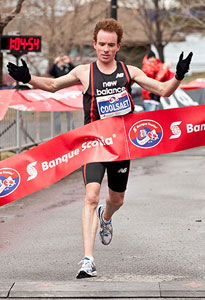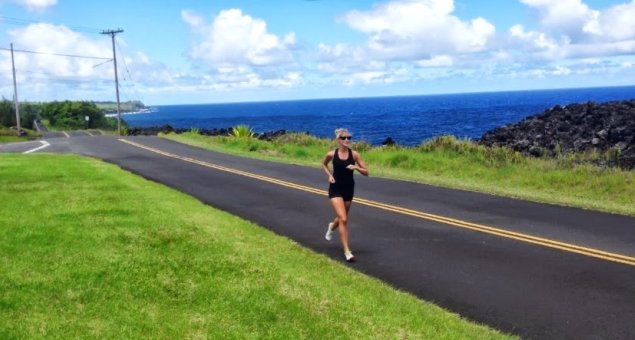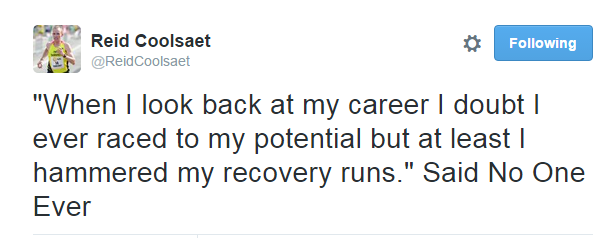 In the past, I have written about the importance of interval training to improve running performance. Yes, it is very important to hammer above your lactate threshold a couple of times per week depending on where you are in your training to get the most out of your body. This is the gold standard of any good performance-oriented running plan. These are your key workouts, and must not be missed.
In the past, I have written about the importance of interval training to improve running performance. Yes, it is very important to hammer above your lactate threshold a couple of times per week depending on where you are in your training to get the most out of your body. This is the gold standard of any good performance-oriented running plan. These are your key workouts, and must not be missed.
That being said, there is still a way to mess up your other runs, and that is by going too fast! Your recovery runs and long runs, for the most part, need to feel slow. This is a rule that most runners know, have read about, completely understand, but it still seems to be one of the top challenges that I see competitive people struggling to conquer. After all, it feels good to run 10-15s/K slower than your 10K race pace for an 8K off-day. It feels fast, the effort is up but manageable, and seeing a close-to-race effort without struggling excessively always provides a nice mental boost.
In this article, I am going to provide an overview behind the physiology of why the long run and recovery runs should be slow. It’s nice to know the rule, but understanding the physiology will help you stick to that rule and slow things down.
Aerobic activity is when our activity is sufficiently fueled by the oxygen we are bringing in. Anaerobic activity is where the oxygen we take in is not sufficient to maintain our level of activity on its own. Aerobic activities are sustainable for long periods of time, but as we shift to a higher level of anaerobic intensities, the time we are able to maintain that activity goes down.
Running is mostly an aerobic sport, and training aerobic adaptations need to be prioritized. For instance, in this article published in Sports Medicine, a nice breakdown of average contributions from each system is provided.
– In marathons, 97.5% of our energy comes from the aerobic system, and 2.5% comes from the anaerobic system. No surprise here. Marathons are long, slow and we don’t breath very heavily when we do them.
– In 5Ks, you are looking at about an 84% aerobic, 16% anaerobic split. Even in a 1-mile race, there is an 80% aerobic 20% anaerobic split. So unless you are training for something REALLY short, your aerobic system is king!
Adaptations to slow running
There are a number of different physiological adaptations that slow running facilitates. The interesting thing is that these adaptations are not enhanced by running slightly faster, but are definitely enhanced by total running time.
Stroke Volume and beyond
For instance, take one of my old articles praising speed work. In this post, I referenced this study, which compared sprint intervals to steady aerobic running. The athletes ended up spending much less time running in the sprint interval group, yet still managed equal performance improvement and VO2 MAX improvements when compared to the endurance running group.
So speed work is better, right? WRONG (kind of). Speed work will definitely give you more bang for your buck with limited training time, and will trigger specific adaptations that slow running never will.
However, running aerobically provides us with adaptations that speed work cannot. In this study, even though the performance improvement was the same, the endurance group showed a more significant increase in stroke volume- a measure of the rate by which our heart can pump blood. The interval group managed to squeak out performance increases in other ways involving more muscular adaptations.
At the end of the day, the total activity time is what improved the heart function of the endurance group. This activity time simply isn’t possible when you are doing sprint intervals, and the heart doesn’t spend enough time pumping blood to reach its full potential!
Another good example of an adaptation that requires time on your feet rather than short bursts of speed is capillary density. These are the smallest of our blood vessels that penetrate deep into our muscles- the more dense they are, the more efficiently oxygen can be transported to them, and the faster we go!
Spending more time on our feet also helps to enhance the efficiency of how we use our fuel sources. With more running, we spend more time oxidizing fat, and as a result, we get better at it. The same goes for glycogen metabolism. This study, as an example, showed that throwing in some double days and in a glycogen depleted state (a state that can be replicated with long slow runs) appears to offer an advantage in enhancing the activity in enzymes needed to break down glycogen while we run.
Long story short- if you run more, lots of neat stuff happens that will make you a more aerobically fit person.
The downside to running fast on easy days
 The two major ones that come to mind are (a) burnout and a decreased ability to perform on speed days and (b) increasing the probability of becoming injured.
The two major ones that come to mind are (a) burnout and a decreased ability to perform on speed days and (b) increasing the probability of becoming injured.
To run above your lactate threshold on your speed days, this takes mental focus, rested muscles and a high level of pain tolerance. If you are coming into these workouts beaten up, or even slightly fatigued from running an off day at 85% of your 10K pace, not only have you achieved no additional gains from pushing yourself during that off day, but now you have sacrificed that very critical workout and time spent above threshold.
If anybody has ever tried to examine the research on training mistakes and injury frequency (oh man have I EVER), you will quickly realize that we do not have clear answers. Take for instance this outstanding review article looking at how factors such as volume, frequency and intensity of training impact injury rates. Long story short, there is conflicting evidence for both sides of each of these training variables. That being said, even with a basic understanding of histology and tissue healing and adaptation, there is a logical approach to follow- beat up your tissues (either with more volume or intensity), but then give them enough time to adapt and heal.
There is no doubt that speed work puts a huge amount of stress on our muscles, ligaments and bones. However, these sessions are so important to perform at our best (especially in the 12 weeks leading up to key races) that we cannot sacrifice them from our training. BUT, does running at 85% of your 5K pace beat up your tissues more so than running at 65-75% of your 5K pace? I suspect it does. Does it offer any additional training benefit? Well, since at 85% of your 5K pace, you will be below threshold, from a cardiovascular standpoint, the answer is probably not (especially since you will not be able to run for the same duration compared to an intensity of 65-75% of your 5K pace).
In summary, if you’re running too fast on your off days, it’s reasonable to suspect that you will be more likely to get hurt, your performance on key workouts will decline, you won’t be able to run long enough, and that specific session will offer little to no additional benefit compared to if you went slow.
What the pros say
I always value research over an individual’s behavior (even if they are the best) when making any sort of final training decision (no argumentum ab auctoritate here- that’s for all you philosophy folks). Regardless, I always find it interesting to see if the science matches what the best do. In this case, it often does. Reid Coolsaet, one of the best marathoners in Canadian history with a 2:10:55 PB tweeted this recently.
“When I look back at my career I doubt I ever raced to my potential but at least I hammered my recovery runs.” Said No One Ever.
 In addition, when modeling our behavior after the best, I think it’s always important to care more about what they ACTUALLY do rather than what they say they do (because who knows if they actually know what they do, let alone tell the truth). Fortunately for us, the internet allows us to see exactly what they do- check out Reid’s Strava account here. Flip through some of his runs. You will notice PLENTY that are 4:20/K and slower. Keep in mind, this is coming from a man who will run sub 3:10/K during a marathon, and well under 3:00/K for a 10K. 4:20/K is a pedestrian pace for him, but he’s doing the right thing. He’s developing aerobic adaptations by spending time on his feet while keeping it slow enough to minimize the risk of injury and to make sure his legs are primed for workout days.
In addition, when modeling our behavior after the best, I think it’s always important to care more about what they ACTUALLY do rather than what they say they do (because who knows if they actually know what they do, let alone tell the truth). Fortunately for us, the internet allows us to see exactly what they do- check out Reid’s Strava account here. Flip through some of his runs. You will notice PLENTY that are 4:20/K and slower. Keep in mind, this is coming from a man who will run sub 3:10/K during a marathon, and well under 3:00/K for a 10K. 4:20/K is a pedestrian pace for him, but he’s doing the right thing. He’s developing aerobic adaptations by spending time on his feet while keeping it slow enough to minimize the risk of injury and to make sure his legs are primed for workout days.
Even Dr. Greg McMillian, physiologist and creator of the famous McMillian running calculator tweeted this recently:
“Not running slow enough on easy days is probably the number-one error goal-driven runners make.”
Before you start messaging me with anecdotes of pros who run fast on easy days, quite possibly the entire Kenyan national team (they run fast in recovery, and probably should not), just know I already am aware of them. This section is more for interest and not meant to convince you to run slow- let the science do that, not what your favourite runner does!
Practical applications
 The main take home is clear: give yourself permission to slow down. If you are a competitive, driven person, oddly enough this can be an extremely difficult challenge! A few things you can do to help yourself includes:
The main take home is clear: give yourself permission to slow down. If you are a competitive, driven person, oddly enough this can be an extremely difficult challenge! A few things you can do to help yourself includes:
– For most of your off day and long runs, stick to 65-75% of your 5K pace.
-Have a training plan for the week and stick to it. Even if you are feeling fresh, or feeling the urge to prove yourself to yourself once again for the 5th time in one week, don’t do it.
-Review recent quality workout data before your easy runs. Sometimes seeing fast paces from 3-4 days ago will remind you that you are still fast, and will help you to feel more comfortable running slowly.
– Review the science (this always helps me). I am definitely guilty of running too fast on long runs at times, but reviewing all the aerobic adaptations my body is developing as I jog really helps me to slow down!
– Go by time rather than distance and pace- forget the Garmin once in a while!
– Remind yourself that people in cars driving by have no idea if you are running 4:00/K or 5:30/K- so don’t worry about people thinking you look slow or fast, because you probably look slow no matter what!
This article covered a lot of ground- if you have any questions or want any additional references, please do not hesitate to let me know. Hopefully I’ve given you some more ammunition to slow down. Happy jogging!
Dr. Sean Delanghe, BSc. (Hons), DC is a chiropractor, coach, and a regular contributor to the RunWaterloo blog.




2 Comments
Awesome article, Sean! Question for you: To have long slow runs mimic the effect of a glycogen depleted state, does the runner need to forgo nutrition throughout the run or does just the run itself provide the same effects?
Good question, thanks for reading! There are two ways to get that glycogen depletion rolling. #1: Start fueled and run long (90-120mins), or #2: Start hungry and run shorter. Both runs play an important role.
Running long while starting fueled (but maybe not taking on that much fuel throughout the run) provides a number of adaptations beyond just improving our glycogen metabolism and fat oxidation, and should be a priority for any runner. That being said, if you are doing a pace driven longer effort, or even a progression run, fueling is important. Having a clear physiological purpose for that long run will make the decision on how to fuel pretty simple.
Short, fasting runs are great easy additional runs to throw into a complete plan to make the plan even better. If you planned for something like a 35-45 minute off-day jog the day after a tough workout, if you are up for a not-so-fun run, doing it in a fasted state is a great way to give that fat oxidation a boost. It’s a good time to do it since you will be going slow anyway. A good protocol would be to complete you workout, eat a normal dinner at a normal or early-ish time, and then to not eat again until you have completed your AM or lunch-time session. These runs are not fun though…and not a good idea if your looking to go long or fast.
Comments are closed.